
Great rivers can, and literally have, caught fire. This week Dr. John Hartig, refuge manager of the Detroit River International Wildlife Refuge and author of
Burning Rivers, explains this phenomenon and writes about those unwilling to let the heritage and wildlife of the Detroit and Rouge River ecosystems go out in flames.
Post 2: Creating a New Waterfront Porch for Wildlife and People
Posted By: John Hartig
Posted: 4/8/2011
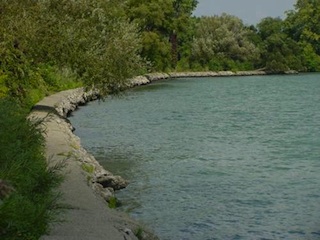 Today, progressive communities are promoting locating both businesses and homes in walkable neighborhoods with front porches on houses that encourage talking with neighbors, keeping in touch with what goes on in the neighborhood, and looking out for one another.
Today, progressive communities are promoting locating both businesses and homes in walkable neighborhoods with front porches on houses that encourage talking with neighbors, keeping in touch with what goes on in the neighborhood, and looking out for one another.
Proponents argue that front porches are a key factor in achieving a sustainable community. Just as house porches can help promote sustainability in neighborhoods, waterfront porches can help promote sustainability of rivers in urban areas.
Historically, houses and businesses in most Great Lakes cities were built facing away from their rivers. Detroit was no exception. In fact, much of the Detroit River shoreline was developed as the back door of commerce and industry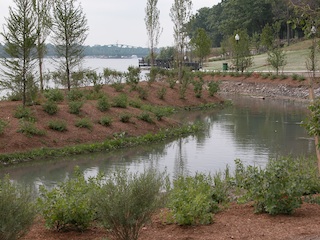 .
.
As commerce and industry expanded in the Detroit metropolitan area, 31 out of 32 miles of U.S. mainland along the Detroit River shoreline were hardened with concrete or steel (hard shoreline engineering), providing no habitat for fish or wildlife. This shoreline hardening contributed to a 97% loss of coastal wetland habitats along the Detroit River.
Today, there is growing interest in reclaiming urban waterfronts with new front porches. Urban planners and developers are using ecological principles and practices to reduce erosion and achieve stability and safety of shorelines, while enhancing habitat, improving aesthetics, enhancing urban quality of life, increasing waterfront property values, and even saving money when compared to installing concrete breakwalls or steel sheet piling. Ecologists refer to this as soft shoreline engineering.
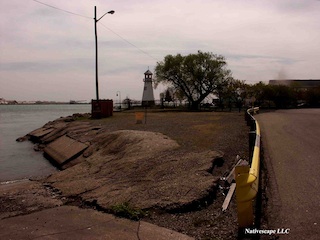 From an ecological perspective, soft shoreline engineering provides much needed habitat and can aid in flood and erosion control. Soft shoreline engineering is particularly important in channelized rivers like the Detroit River because of the amount of shoreline hardened with concrete breakwalls and steel sheet piling. Soft engineered shorelines provide spawning and nursery habitat for many fishes and are critically important to larval fish as they provide shelter, resting areas, food, and a chance to grow a little bigger and stronger on a larval fish's trip downstream to Lake Erie.
From an ecological perspective, soft shoreline engineering provides much needed habitat and can aid in flood and erosion control. Soft shoreline engineering is particularly important in channelized rivers like the Detroit River because of the amount of shoreline hardened with concrete breakwalls and steel sheet piling. Soft engineered shorelines provide spawning and nursery habitat for many fishes and are critically important to larval fish as they provide shelter, resting areas, food, and a chance to grow a little bigger and stronger on a larval fish's trip downstream to Lake Erie.
Not only is soft shoreline engineering important for enhancing aquatic habitat and providing other ecological benefits, it is important from a social perspective because it helps reconnect people with the natural world. Soft shoreline engineering is increasingly becoming a vital element in making places special or unique and in fostering a sense of belonging in urban areas like 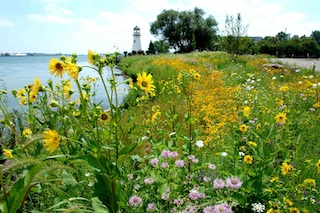 Detroit. Indeed, waterfronts are magical places where the water meets the land and people can reconnect with their watershed. Experience has shown that reconnecting people to the river by creating waterfront vistas, reintroducing watershed residents to river history, geography, and ecology, establishing unique conservation places linked by greenway trails and blueways (i.e., canoe and kayak trails), promoting ecotourism, and championing green waterfront developments also help build a political base for a sustainable community.
Detroit. Indeed, waterfronts are magical places where the water meets the land and people can reconnect with their watershed. Experience has shown that reconnecting people to the river by creating waterfront vistas, reintroducing watershed residents to river history, geography, and ecology, establishing unique conservation places linked by greenway trails and blueways (i.e., canoe and kayak trails), promoting ecotourism, and championing green waterfront developments also help build a political base for a sustainable community.
Finally, we cannot lose sight of the economic benefits. Environment Canada has performed economic studies of greenways, natural areas, and parks on the Canadian side of the Detroit River in Windsor, Ontario. These studies show that the closer houses are to greenways, natural areas, parks, and gathering places for wildlife and people, the higher the property values.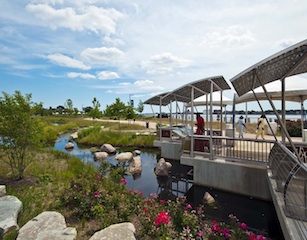
These green spaces and vistas also bring benefits through additional recreational spending and increased commercial activity. The economic importance of this was highlighted in a 2006 Outdoor Industry Foundation economic study that found that outdoor recreation contributes $730 billion annually to the U.S. economy and supports nearly 6.5 million jobs across the United States.
Much like the effort to recreate front porches on houses in cities to encourage a sense of community, soft engineered shorelines along waterfronts in urban areas can help recreate gathering places for both wildlife and people.
Note: In the past 10 years, 38 soft shoreline engineering projects have been implemented in the Detroit River watershed. 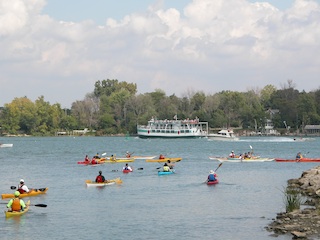 Look here for more information on these projects.
Look here for more information on these projects.
Photos:
Wayne County’s Elizabeth Park shoreline before restoration (courtesy of U.S. Fish and Wildlife Service)
Wayne County’s Elizabeth Park shoreline after restoration (courtesy of U.S. Fish and Wildlife Service)DTE Energy’s River Rouge Power Plant shoreline before restoration (courtesy of Nativescape)
DTE Energy’s River Rouge Power Plant shoreline after restoration (courtesy of Nativescape)
Milliken State Park storm water treatment system designed by JJR along the Detroit RiverWalk (courtesy of JJR)
Kayaking along the soft engineered shoreline of Elizabeth Park in Trenton (courtesy of Janis Lane)